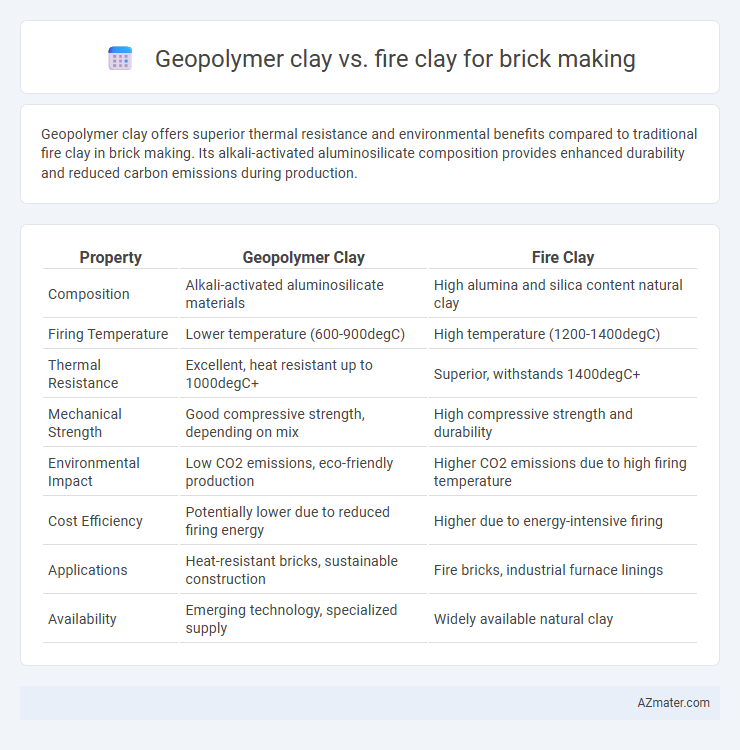Geopolymer clay offers superior thermal resistance and environmental benefits compared to traditional fire clay in brick making. Its alkali-activated aluminosilicate composition provides enhanced durability and reduced carbon emissions during production.
Table of Comparison
| Property | Geopolymer Clay | Fire Clay |
|---|---|---|
| Composition | Alkali-activated aluminosilicate materials | High alumina and silica content natural clay |
| Firing Temperature | Lower temperature (600-900degC) | High temperature (1200-1400degC) |
| Thermal Resistance | Excellent, heat resistant up to 1000degC+ | Superior, withstands 1400degC+ |
| Mechanical Strength | Good compressive strength, depending on mix | High compressive strength and durability |
| Environmental Impact | Low CO2 emissions, eco-friendly production | Higher CO2 emissions due to high firing temperature |
| Cost Efficiency | Potentially lower due to reduced firing energy | Higher due to energy-intensive firing |
| Applications | Heat-resistant bricks, sustainable construction | Fire bricks, industrial furnace linings |
| Availability | Emerging technology, specialized supply | Widely available natural clay |
Introduction to Geopolymer Clay and Fire Clay
Geopolymer clay is an innovative material composed of aluminosilicate sources activated by alkaline solutions, offering enhanced durability and environmental benefits compared to traditional clays. Fire clay, a naturally occurring refractory clay with a high alumina content, is known for its excellent heat resistance and stability under high temperatures. Both materials serve as primary substances in brick making, with geopolymer clay providing eco-friendly alternatives and fire clay ensuring high thermal performance.
Chemical Composition Differences
Geopolymer clay primarily consists of aluminosilicate materials activated by alkaline solutions, rich in silicon dioxide (SiO2) and aluminum oxide (Al2O3), which form a durable, eco-friendly binder through polymerization. Fire clay contains higher amounts of kaolinite and mullite phases, with significant silica (SiO2), alumina (Al2O3), and iron oxide (Fe2O3), offering excellent refractory properties due to its thermal stability. The chemical composition difference lies in geopolymer clay's reliance on synthetic alkaline activation for hardening, whereas fire clay relies on its natural mineral phases to withstand high temperatures.
Manufacturing Processes Compared
Geopolymer clay brick manufacturing involves alkali-activated compounds cured at ambient or slightly elevated temperatures, reducing energy consumption compared to fire clay bricks that require high-temperature kilning above 1000degC. Geopolymer bricks utilize industrial byproducts like fly ash and slag mixed with clay, enabling faster setting times and lower carbon emissions versus traditional fire clay bricks reliant on natural refractory clay and prolonged firing cycles. The geopolymer process allows for near-net shape molding with less shrinkage, while fire clay bricks undergo extensive drying and firing stages to achieve dense, heat-resistant properties.
Environmental Impact Assessment
Geopolymer clay bricks exhibit significantly lower carbon emissions compared to traditional fire clay bricks due to their reduced reliance on high-temperature kiln firing and the use of industrial by-products like fly ash or slag. The life cycle assessment of geopolymer bricks reveals substantial energy savings and decreased air pollution, contributing to a smaller overall environmental footprint. Fire clay bricks require extensive mining and energy-intensive processing, resulting in higher greenhouse gas emissions and ecological degradation in extraction areas.
Thermal Resistance and Durability
Geopolymer clay bricks exhibit superior thermal resistance compared to traditional fire clay bricks, withstanding temperatures above 1000degC without significant structural degradation. The geopolymer matrix enhances durability by providing high chemical resistance and reduced porosity, resulting in longer-lasting bricks under harsh environmental conditions. Fire clay bricks, while known for good refractory properties, generally show lower resistance to thermal shock and gradual wear compared to advanced geopolymer variants.
Cost Effectiveness Analysis
Geopolymer clay offers significant cost savings over traditional fire clay for brick making due to lower raw material expenses and reduced energy consumption during curing, as it requires ambient or low-temperature curing instead of high-temperature firing. Fire clay bricks incur higher production costs related to fuel consumption and kiln maintenance, often exceeding 20-30% of total manufacturing expenses. Optimizing geopolymer formulations enhances cost efficiency by minimizing waste and accelerating production cycles, leading to improved economic viability in large-scale brick manufacturing operations.
Applications in Brick Making
Geopolymer clay and fire clay are both essential materials in brick making, with geopolymer clay offering enhanced environmental benefits through reduced carbon emissions and improved thermal resistance. Fire clay provides high refractoriness and durability, making it ideal for heat-resistant bricks used in furnaces, kilns, and fireplaces. Geopolymer clay bricks excel in sustainable construction and insulation applications, while fire clay bricks remain preferred for industrial and high-temperature environments.
Mechanical Properties Comparison
Geopolymer clay bricks exhibit higher compressive strength and improved durability compared to traditional fire clay bricks due to the enhanced chemical bonding within the geopolymer matrix. Fire clay bricks typically show better thermal resistance and refractoriness but have lower tensile strength and flexural strength than geopolymer clay bricks. Mechanical properties such as modulus of rupture and hardness are significantly superior in geopolymer clay bricks, making them suitable for structural applications requiring high load-bearing capacity.
Sustainability and Lifecycle
Geopolymer clay bricks offer superior sustainability compared to fire clay bricks by utilizing industrial by-products like fly ash, significantly reducing carbon emissions during production. The lifecycle of geopolymer bricks demonstrates enhanced durability and resistance to chemical corrosion, decreasing maintenance needs and extending service life. Fire clay bricks, while traditionally durable, involve higher energy consumption and environmental impact during mining and firing processes, making them less eco-friendly over their lifecycle.
Future Trends in Clay-Based Brick Production
Geopolymer clay is gaining traction over traditional fire clay due to its lower carbon footprint and enhanced thermal resistance, aligning with sustainable building practices. Innovations in geopolymer formulations enable rapid curing times and superior mechanical properties, making it a preferred material for eco-friendly brick production. Future trends emphasize integrating industrial byproducts and optimizing geopolymer technology to reduce environmental impact and improve durability in clay-based bricks.

Infographic: Geopolymer clay vs Fire clay for Brick making
 azmater.com
azmater.com